Accommodation and Dining during EBC Trek in Nepal
Trekking in the Himalayas is a favorite pastime of hikers and fitness enthusiasts from around the globe. The region of Nepal where the treks are is one of the most popular trekking destinations in the world, and the country sees many thousands of visitors every year, trekking the trails to Everest, Annapurna, and many other high mountains.
Overview
If you are used to camping in a tent on your trekking expeditions, you will be amazed at the comparative luxury that you can have when trekking in Nepal. From dome tents with mattresses on the ground and dining tables for dinner, to the tea lodges that are an integral part of Nepal trekking, there are plenty of places to stay when trekking around the region.
 It is easy to find food and accommodation while trekking EBC in Nepal.
It is easy to find food and accommodation while trekking EBC in Nepal.
Detailed introduction of lodges and food
It is a bit pretentious to call some village establishments “hotels”, but the most common word in Nepali for restaurant or eating place translates as “hotel”. Since the word hotel has been pre-empted, Nepalese people use the word lodge for a sleeping place or inn. Therefore, in the hills of Nepal a hotel has food, but may not provide a place to sleep, while a lodge always offers accommodation. Many innkeepers specify the services they provide by calling their establishments Hotel & Lodge. In reality, you can almost always find food and some kind of accommodation at any trailside establishment.
With the growth of the trekking industry, facilities have improved and there is now an extensive system of lodges serving major routes. Most hotels in the hills are family-run affairs that started in the living room and grew as more and more trekkers appeared. Many lodges now have private rooms for guests, but at some, the family that operates the inn eats and sleeps in the same building, and often the same room, that it offers to guests. Since the 1970s, the money from trekking lodges has become the major source of income in many hill villages.
Features such as pavement cafes, sun rooms, private rooms, indoor Western-style toilets and electric lights abound. Lodges compete for the attention of your stomach with offerings of cake, pie, pizza, steaks, tacos, enchiladas and spaghetti bolognaise. There are some excellent lodges in the hills, but there are many more establishments that are second-rate. The hot shower may turn out to be simply a bucket of lukewarm water and the toilet may be a latrine behind the hotel. The private room can be a wooden cell with no furniture except a bed, mattress and curtain in place of the door. However, compared to camping out on the trail in a tent in the blistering cold after a long day trekking, even these seem like the height of luxury.
Lukla
Since the flights from Kathmandu to Lukla normally arrive in the morning, very few people stay their first night in Lukla. Majority prefer to get on the trail straight away, and head for the first stop at Phakding or Namche. That does not mean there are no lodges in Lukla. There are plenty, and the accommodation is usually well above the standards higher up the mountains. There are also some very good hotels to stay in, although they are a little more expensive than the lodges. The facilities are much better than the tea lodges of the trail, and many have landscaped lawns, balcony rooms, and patio dining for their guests, not to mention that ever-welcome hot shower.
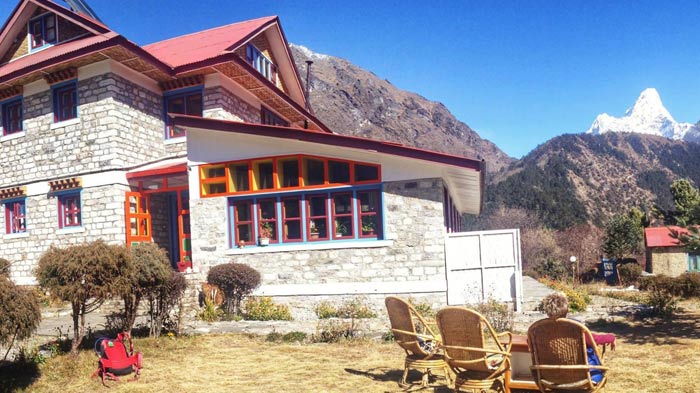 The accommodation is usually well above the standards higher up the mountains
The accommodation is usually well above the standards higher up the mountains
Being at the trailhead for the EBC trek means that Lukla has the first of the imported goods and foods that come to the Khumbu region for the Everest lodges, and the meals are good, solid food at a very reasonable price. You can get almost anything, from curry to pizza, as well as the local dishes if you really want them. Though after two weeks of trekking, you may not want to see Dahl Bhat again. The lodges are also useful for hiring porters, and many of the local porters who are not at the airport meeting the flights, can be found in the lodges, touting for business.
>> Read more about Different Trekking Routes to EBC from Lukla
Phakding
This small town is located 3 to 4 hours from Lukla, and 5 to 6 hours from Namche Bazaar. Since most flights into Lukla arrive in the morning, many trekkers (about 90% in fact) like to get walking straight way and overnight in Phakding before heading to Namche Bazaar to acclimatize. With hotels on both sides of the river, Phakding has enough hotels to accommodate everyone, including a Yeti Mountain Home for those with a bit more budget and who like a bit more comfort.
 Phakding has enough hotels to accommodate everyone
Phakding has enough hotels to accommodate everyone
Food in the lodges at Phakding is comparable to that in Lukla, and is just as reasonably priced. This is really the start of the tea lodge trail to EBC, and this is most likely where you will experience your first plate of Dahl Bhat. This delicious, energizing, filling dish is going to be your staple diet for the next two weeks, and it is a good thing that everyone cooks it differently.
Namche Bazaar
Namche Bazaar is the biggest commercial town in the Everest Region, and famous the world over thanks to Everest summiteers. With more than 90% of the trekkers passing through spending three nights in Namche (two on the way up to acclimatize and one on the way back), it’s no surprise that there are an abundance of hotels, around 50 in fact, and a wide range of prices, from basic to deluxe.
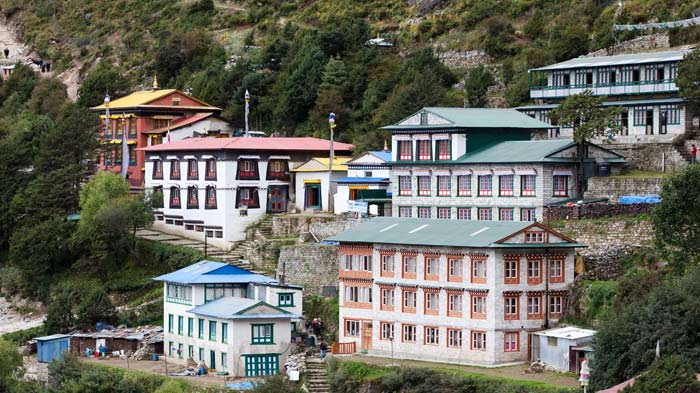 There are an abundance of hotels
There are an abundance of hotels
Namche is the last place where you can find the fancier lodges on the trail to EBC, which provide good food in all styles at a reasonable price, although a little more than in Lukla. There are also a few restaurants in the village, which are set to serve the trekkers and tourists to the region. From Namche up, the prices start to get higher and the accommodations more basic, which is only to be expected, so enjoy the comparative luxury of Namche.
Tengboche
Tengboche is famous for its monastery, situated at 3,867m, which is the largest monastery in the Khumbu Region. The panoramic views from the monastery are spectacular. With only 5 hotels in Tengboche and many people wanting to stay overnight to attend morning prayers at the monastery, it can be crowded in the peak season. There are other lodges in Tengboche as well, and several small cafes that cater to the trekking tourists. The food is a little more expensive than the lower villages, though, and there is less choice from hereon up.
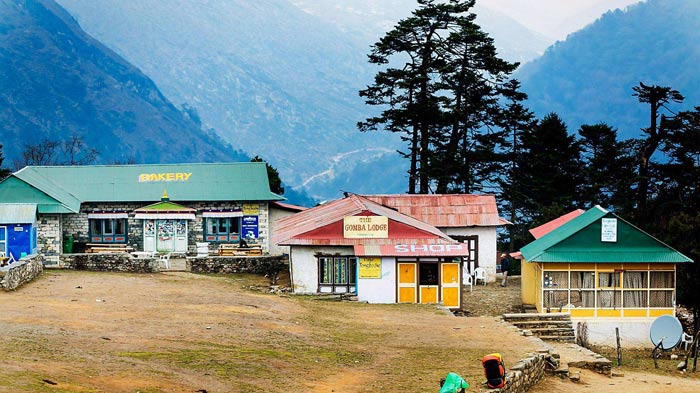 There are only 5 hotels in Tengboche
There are only 5 hotels in Tengboche
Pheriche
Located north of Dingboche, Pheriche is a popular stop for trekkers and climbers. There is a rudimentary hospital in Pheriche that is operated under the auspices of the Himalayan Rescue Association (HRA). There are a couple of dozen lodges in Pheriche, since it is the popular stopping place for the acclimatization day, before pushing on to higher altitudes at Gorak Shep. There are no trees this high in the valley; there are small, tough grasses and other tundra vegetation, but nothing to obscure your views of the nearby mountains.
 Pheriche is a popular stop for trekkers and climbers
Pheriche is a popular stop for trekkers and climbers
Just to the north of Pheriche is a field full of cairns that memorialize the climbers who were lost in the mountains. Pheriche is primarily a farming village, but the tourist trade seems to have taken over, and many locals work as porters and guides, while others have opened their homes as lodges to cater for the influx of foreign tourists. The lodges are pretty basic here, especially since the 2015 earthquake with hit the region hard, and the food is basic too, although you can still find pizza rols and such in some of the lodges.
Duglha
Another one of the nicer places to stop for the night on most treks, Duglha, or Thukla as it is known locally, is the last place where you will see the tea lodges until you reach Lobuche, 330 meters further up the mountain. The village consists of a few houses scattered along the trail side, and around a dozen or so lodges that are the best place to stop for lunch if you are pushing on to Lobuche for the night.
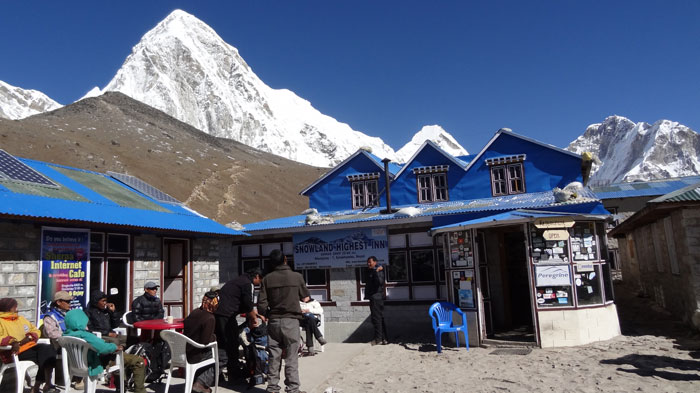 Duglha
Duglha
For those staying overnight, the lodges are very basic, and most are just extensions of the family’s home that have been turned into tourist guesthouses. The families also live inside the lodges this high up in the mountains, so it can get a little noisy in the evening before everyone has gone to sleep. The food is basic as well, with few western dishes, and many varieties of Dahl Bhat, which you will find welcoming with its filling consistency and stomach-warming flavors.
Lobuche
Lobuche is basically a village of hotels. However, apart from the high end hotels, accommodation here is quite basic and can be hard to find in the peak season. For those aiming to climb the Lobuche Peak, or for those who have their own tents, to the south west of Lobuche, there is a camping area. Tents are actually optional here, as there are tent-hotels in the camping area in the peak seasons, which cater to all kinds of trekkers and climbers. The lodges in the village are very basic, in both design and facilities. Many of them are known to be notoriously primitive, consisting mostly of stone huts with shared bunk dormitories.
 Lobuche is basically a village of hotels
Lobuche is basically a village of hotels
In recent years, there have been some additions of more modern facilities and amenities including seven newly-built lodges providing over 200 twin-bed rooms. Some lodges even provide internet and oxygen services, although the internet is slow and expensive. Food in Lobuche is better than previously, since more supplies are being brought up the trail by the porters to accommodate the newer lodges.
Gorak Shep
Gorak Shep has the final five lodges or hotels before heading to Everest Base Camp. Always crowded, accommodation is very basic, and do not be surprised if you have to share a room with other trekkers or have to sleep in the dining room. Although at least in the dining room it would be warmer for a little while, until the fire dies down. This frozen lakebed covered in sand is the last outpost before EBC, and is a stopping point for everyone who goes to Everest. Which begs the question, why are there only five lodges?
 Gorak Shep
Gorak Shep
Gorak Shep was the original base camp for climbers in the 1950s before moving closer to the base of the mountain, just below the infamous Khumbu Ice Fall. The lodge is a common place for trekkers, guides, and porters to hang out in the evening and is more crowded than most lodges on the trek due to limited housing. Nights are cold in the rooms, and often the water in the toilet is frozen too. The food, however, is better than in many places along the trail, and the old favorites are back, from pizza rolls to chicken curry. Prices, however, are not the same this high up the mountain. The cost of transporting the supplies is much higher, which makes the meals much more expensive than anywhere else on the trail. If budget is an issue, it is advisable to bring your own dried and packaged foods.
Join-in Nepal Everest Base Camp Trekking Tours
Food and beverage you need to prepare yourself during the trek
For most people trekking along the EBC trail, using the lodges and tea houses for their meals is easy. Wherever you are on the mountain, there is a lodge or teahouse usually within a few hours trek of your current location. That is almost a guarantee. It is easy to trek to the next lodge for lunch, and then carry on to the following one for dinner and bed, and packing your own supplies is not really required.
 Dining in the tea lodge on EBC trekking trail
Dining in the tea lodge on EBC trekking trail
The main things you need to prepare yourself when trekking to EBC are your snacks for the trail ahead - since it is high altitude and you lose energy faster - and your water for drinking. Water is the most important thing in the high altitude of Nepal, and you can quickly become dehydrated. While water is available from the lodges and teahouses, it is costly, and you may run out on the trail if you are not carrying enough. The best thing to do here is to use water purifying tablets to cleanse the normal tap or stream water so you can drink as much as you like without a huge cost.
>> Read more about Ultimate Packing List for EBC Trek in Nepal
More Mount Everest Base Camp Travel Guide
 Mt.Everest Fact
Mt.Everest Fact- Everest Base Camp Nepal vs Everest Base Camp Tibet
- Mount Everest History and Its Famous Explorers
- The Difference of Mt.Everest in Nepal and Tibet
- Kathmandu to EBC Distance: how far and how to get to EBC in Nepal and Tibet from Kathmandu
- How Many Base Camps on Everest in Both Sides of Tibet and Nepal
 Everest Base Camp Tour Guide
Everest Base Camp Tour Guide- When is the Best Time to Visit Tibet Everest Base Camp in 2024
- When is the Best Time to Enjoy EBC Trek in Nepal
- The Best Hotel at Everest Base Camp in Tibetan Side
- Guide to Tibet Everest Base Camp Tour in Winter
- How to Get to Everest Base Camp (EBC) from Nepal?
- How to Get to Mount Everest Base Camp from Lhasa
- What Documents Do I Need for Everest Base Camp Tour in Tibet and Nepal?
 Everest Trekking Guide
Everest Trekking Guide- What to Pack for Everest Base Camp Trek
- Tingri to Everest Base Camp Trekking
- Everest Trek: Trekking Routes along The Gama Valley
- Everest Base Camp Trekking Maps in Tibet
- Ultimate Packing List for Everest Base Camp Trek in Tibet
- Best Trek in Nepal: Everest Base Camp Trek vs. Annapurna Circuit Trek
- Top 2 EBC Trekking Routes in Tibet
- EBC Trek in Tibet vs. EBC Trek in Nepal

Recommended Nepal Everest Base Camp Tour Packages
-
 Mount Everest Climbing Expedition in Nepal
Mount Everest Climbing Expedition in NepalTour Route:Kathmandu - Lukla - Phakding - Namche Bazaar - Tengboche - Dingboche - Duglha - Lobuche - Everest Base Camp - Mount Everest - Lukla - Kathmandu
-
 10 Days Everest Panorama View Trek Tour
10 Days Everest Panorama View Trek TourTour Route:Kathmandu - Lukla- Phakding- Namche Bazaar- Khumjung- Tengboche- Monjo- Kathmandu
-
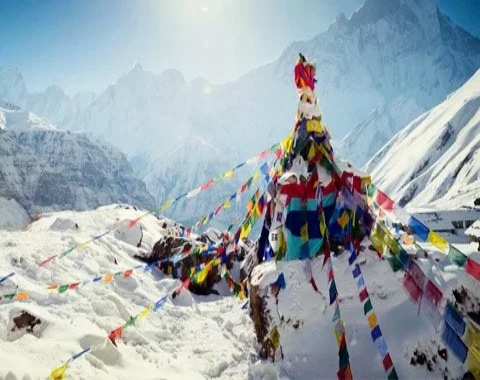 17 Days Nepal Everest Base Camp Trek Tour
17 Days Nepal Everest Base Camp Trek TourTour Route:Kathmandu - Phakding-Namche Bazaar-Tengboche- Dingboche- Lobuche-Gorakshep- Everest base camp-Kathmandu
-
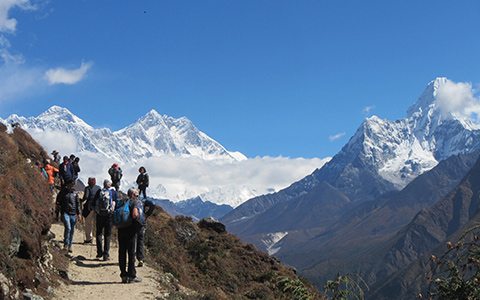 26 Days Everest Panoramic Trek in both Nepal and Tibet
26 Days Everest Panoramic Trek in both Nepal and TibetTour Route:Lhasa - Gyantse - Everest Base Camp - Gyirong Border - Rasuwagadhi - Kathmandu - Lukla - Phakding - Namche Bazaar - Everest Base Camp - Lukla - Kathmandu


.jpg)




0 Comment ON "Accommodation and Dining during EBC Trek in Nepal"